DFMB1_GM_ASMG_v1 Project: Industry Knowledge and the Lending Process
VerifiedAdded on 2023/06/10
|21
|5510
|342
Project
AI Summary
This project focuses on industry knowledge and the lending process within the context of the DFMB1_GM_ASMG_v1 module. It involves building professional relationships, understanding internal and external networks, and adhering to legislative and regulatory requirements when communicating with network partners. The project requires students to identify and maintain professional relationships, explain the benefits of these connections to the broking business, and outline communication channels used to develop and maintain these relationships. Additionally, it covers the importance of client confidentiality and adherence to organizational policies and procedures. The student response includes examples of internal and external networks, benefits of connections, actions to maintain relationships, and communication methods, demonstrating an understanding of the material with opportunities for further development.

Written Project
DFMB1_GM_ASMG_v1
DFMB1_GM_ASMG_v1
Paraphrase This Document
Need a fresh take? Get an instant paraphrase of this document with our AI Paraphraser
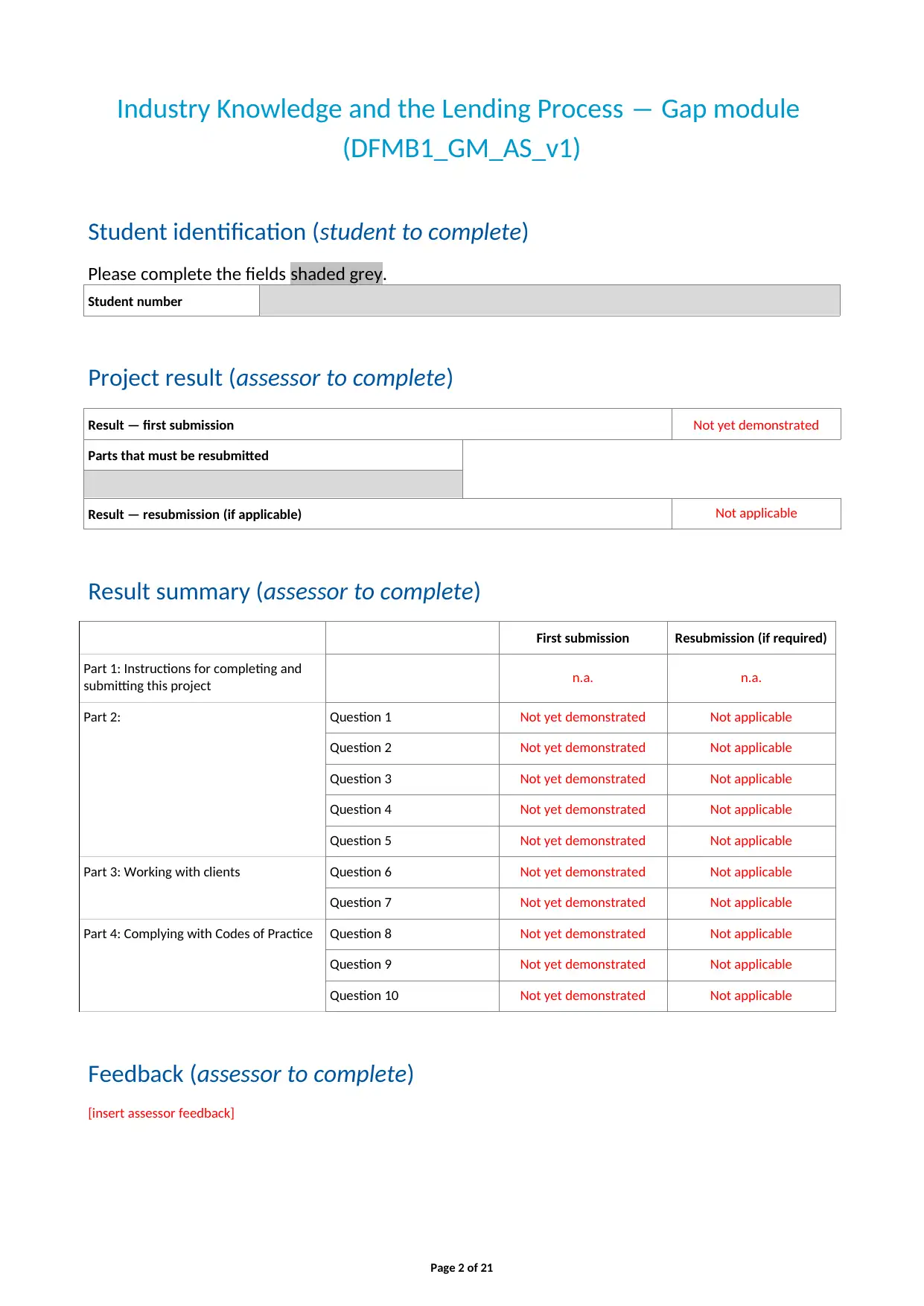
Industry Knowledge and the Lending Process ― Gap module
(DFMB1_GM_AS_v1)
Student identification (student to complete)
Please complete the fields shaded grey.
Student number
Project result (assessor to complete)
Result — first submission Not yet demonstrated
Parts that must be resubmitted
Result — resubmission (if applicable) Not applicable
Result summary (assessor to complete)
First submission Resubmission (if required)
Part 1: Instructions for completing and
submitting this project n.a. n.a.
Part 2: Question 1 Not yet demonstrated Not applicable
Question 2 Not yet demonstrated Not applicable
Question 3 Not yet demonstrated Not applicable
Question 4 Not yet demonstrated Not applicable
Question 5 Not yet demonstrated Not applicable
Part 3: Working with clients Question 6 Not yet demonstrated Not applicable
Question 7 Not yet demonstrated Not applicable
Part 4: Complying with Codes of Practice Question 8 Not yet demonstrated Not applicable
Question 9 Not yet demonstrated Not applicable
Question 10 Not yet demonstrated Not applicable
Feedback (assessor to complete)
[insert assessor feedback]
Page 2 of 21
(DFMB1_GM_AS_v1)
Student identification (student to complete)
Please complete the fields shaded grey.
Student number
Project result (assessor to complete)
Result — first submission Not yet demonstrated
Parts that must be resubmitted
Result — resubmission (if applicable) Not applicable
Result summary (assessor to complete)
First submission Resubmission (if required)
Part 1: Instructions for completing and
submitting this project n.a. n.a.
Part 2: Question 1 Not yet demonstrated Not applicable
Question 2 Not yet demonstrated Not applicable
Question 3 Not yet demonstrated Not applicable
Question 4 Not yet demonstrated Not applicable
Question 5 Not yet demonstrated Not applicable
Part 3: Working with clients Question 6 Not yet demonstrated Not applicable
Question 7 Not yet demonstrated Not applicable
Part 4: Complying with Codes of Practice Question 8 Not yet demonstrated Not applicable
Question 9 Not yet demonstrated Not applicable
Question 10 Not yet demonstrated Not applicable
Feedback (assessor to complete)
[insert assessor feedback]
Page 2 of 21
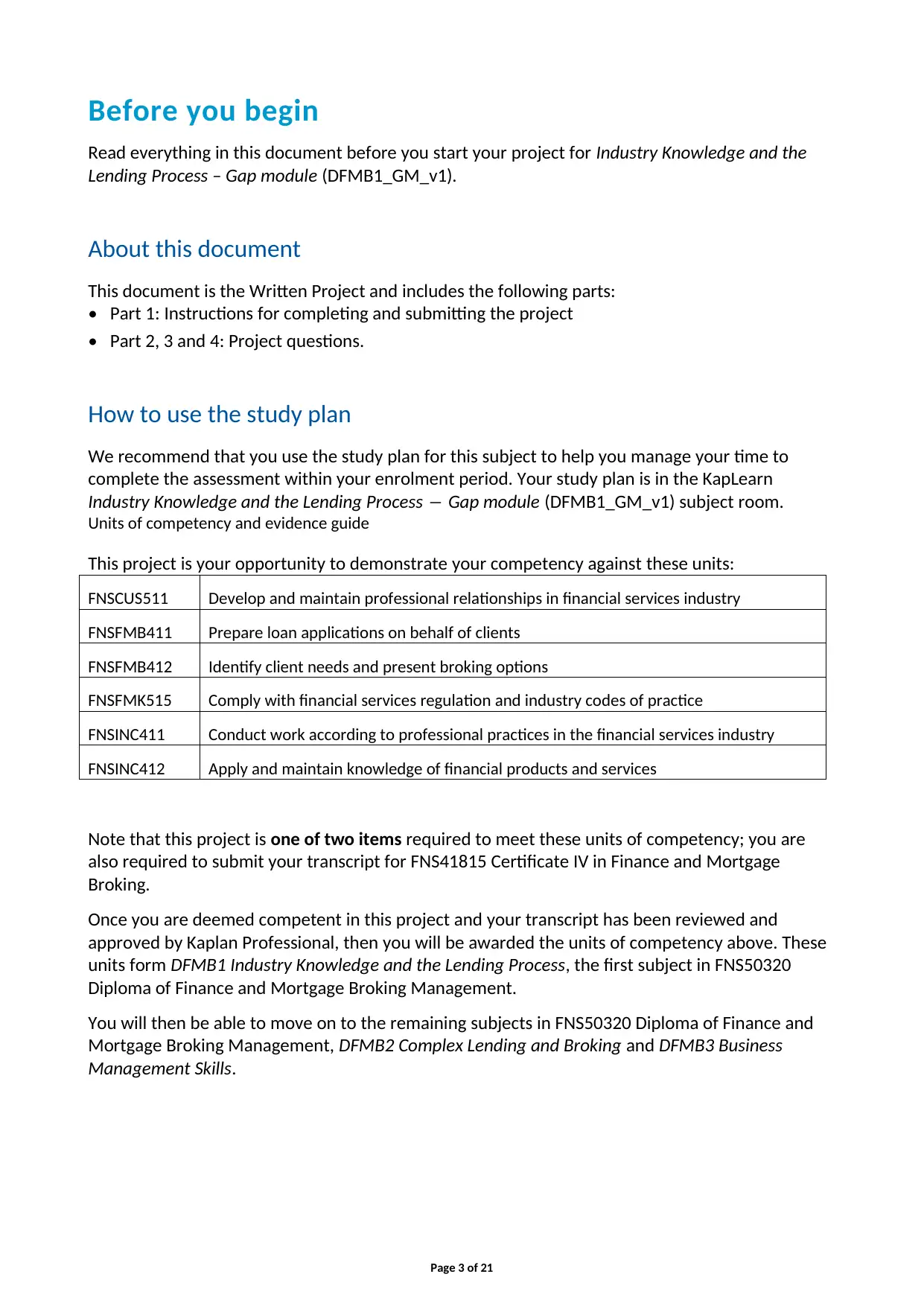
Before you begin
Read everything in this document before you start your project for Industry Knowledge and the
Lending Process – Gap module (DFMB1_GM_v1).
About this document
This document is the Written Project and includes the following parts:
• Part 1: Instructions for completing and submitting the project
• Part 2, 3 and 4: Project questions.
How to use the study plan
We recommend that you use the study plan for this subject to help you manage your time to
complete the assessment within your enrolment period. Your study plan is in the KapLearn
Industry Knowledge and the Lending Process ― Gap module (DFMB1_GM_v1) subject room.
Units of competency and evidence guide
This project is your opportunity to demonstrate your competency against these units:
FNSCUS511 Develop and maintain professional relationships in financial services industry
FNSFMB411 Prepare loan applications on behalf of clients
FNSFMB412 Identify client needs and present broking options
FNSFMK515 Comply with financial services regulation and industry codes of practice
FNSINC411 Conduct work according to professional practices in the financial services industry
FNSINC412 Apply and maintain knowledge of financial products and services
Note that this project is one of two items required to meet these units of competency; you are
also required to submit your transcript for FNS41815 Certificate IV in Finance and Mortgage
Broking.
Once you are deemed competent in this project and your transcript has been reviewed and
approved by Kaplan Professional, then you will be awarded the units of competency above. These
units form DFMB1 Industry Knowledge and the Lending Process, the first subject in FNS50320
Diploma of Finance and Mortgage Broking Management.
You will then be able to move on to the remaining subjects in FNS50320 Diploma of Finance and
Mortgage Broking Management, DFMB2 Complex Lending and Broking and DFMB3 Business
Management Skills.
Page 3 of 21
Read everything in this document before you start your project for Industry Knowledge and the
Lending Process – Gap module (DFMB1_GM_v1).
About this document
This document is the Written Project and includes the following parts:
• Part 1: Instructions for completing and submitting the project
• Part 2, 3 and 4: Project questions.
How to use the study plan
We recommend that you use the study plan for this subject to help you manage your time to
complete the assessment within your enrolment period. Your study plan is in the KapLearn
Industry Knowledge and the Lending Process ― Gap module (DFMB1_GM_v1) subject room.
Units of competency and evidence guide
This project is your opportunity to demonstrate your competency against these units:
FNSCUS511 Develop and maintain professional relationships in financial services industry
FNSFMB411 Prepare loan applications on behalf of clients
FNSFMB412 Identify client needs and present broking options
FNSFMK515 Comply with financial services regulation and industry codes of practice
FNSINC411 Conduct work according to professional practices in the financial services industry
FNSINC412 Apply and maintain knowledge of financial products and services
Note that this project is one of two items required to meet these units of competency; you are
also required to submit your transcript for FNS41815 Certificate IV in Finance and Mortgage
Broking.
Once you are deemed competent in this project and your transcript has been reviewed and
approved by Kaplan Professional, then you will be awarded the units of competency above. These
units form DFMB1 Industry Knowledge and the Lending Process, the first subject in FNS50320
Diploma of Finance and Mortgage Broking Management.
You will then be able to move on to the remaining subjects in FNS50320 Diploma of Finance and
Mortgage Broking Management, DFMB2 Complex Lending and Broking and DFMB3 Business
Management Skills.
Page 3 of 21
⊘ This is a preview!⊘
Do you want full access?
Subscribe today to unlock all pages.

Trusted by 1+ million students worldwide
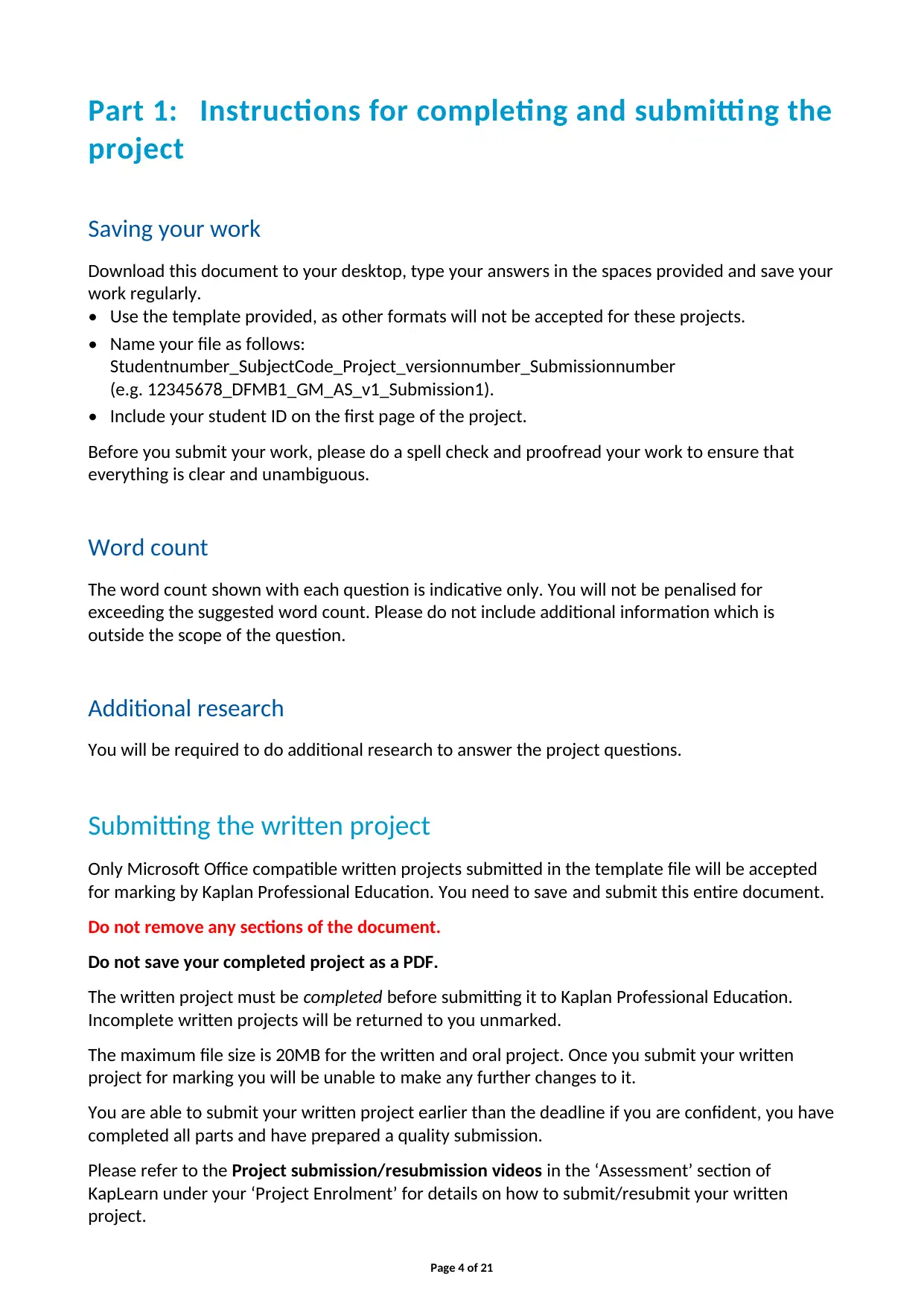
Part 1: Instructions for completing and submitting the
project
Saving your work
Download this document to your desktop, type your answers in the spaces provided and save your
work regularly.
• Use the template provided, as other formats will not be accepted for these projects.
• Name your file as follows:
Studentnumber_SubjectCode_Project_versionnumber_Submissionnumber
(e.g. 12345678_DFMB1_GM_AS_v1_Submission1).
• Include your student ID on the first page of the project.
Before you submit your work, please do a spell check and proofread your work to ensure that
everything is clear and unambiguous.
Word count
The word count shown with each question is indicative only. You will not be penalised for
exceeding the suggested word count. Please do not include additional information which is
outside the scope of the question.
Additional research
You will be required to do additional research to answer the project questions.
Submitting the written project
Only Microsoft Office compatible written projects submitted in the template file will be accepted
for marking by Kaplan Professional Education. You need to save and submit this entire document.
Do not remove any sections of the document.
Do not save your completed project as a PDF.
The written project must be completed before submitting it to Kaplan Professional Education.
Incomplete written projects will be returned to you unmarked.
The maximum file size is 20MB for the written and oral project. Once you submit your written
project for marking you will be unable to make any further changes to it.
You are able to submit your written project earlier than the deadline if you are confident, you have
completed all parts and have prepared a quality submission.
Please refer to the Project submission/resubmission videos in the ‘Assessment’ section of
KapLearn under your ‘Project Enrolment’ for details on how to submit/resubmit your written
project.
Page 4 of 21
project
Saving your work
Download this document to your desktop, type your answers in the spaces provided and save your
work regularly.
• Use the template provided, as other formats will not be accepted for these projects.
• Name your file as follows:
Studentnumber_SubjectCode_Project_versionnumber_Submissionnumber
(e.g. 12345678_DFMB1_GM_AS_v1_Submission1).
• Include your student ID on the first page of the project.
Before you submit your work, please do a spell check and proofread your work to ensure that
everything is clear and unambiguous.
Word count
The word count shown with each question is indicative only. You will not be penalised for
exceeding the suggested word count. Please do not include additional information which is
outside the scope of the question.
Additional research
You will be required to do additional research to answer the project questions.
Submitting the written project
Only Microsoft Office compatible written projects submitted in the template file will be accepted
for marking by Kaplan Professional Education. You need to save and submit this entire document.
Do not remove any sections of the document.
Do not save your completed project as a PDF.
The written project must be completed before submitting it to Kaplan Professional Education.
Incomplete written projects will be returned to you unmarked.
The maximum file size is 20MB for the written and oral project. Once you submit your written
project for marking you will be unable to make any further changes to it.
You are able to submit your written project earlier than the deadline if you are confident, you have
completed all parts and have prepared a quality submission.
Please refer to the Project submission/resubmission videos in the ‘Assessment’ section of
KapLearn under your ‘Project Enrolment’ for details on how to submit/resubmit your written
project.
Page 4 of 21
Paraphrase This Document
Need a fresh take? Get an instant paraphrase of this document with our AI Paraphraser

Your written project must be submitted on or before your due date. Please check KapLearn for
the due date.
Page 5 of 21
the due date.
Page 5 of 21
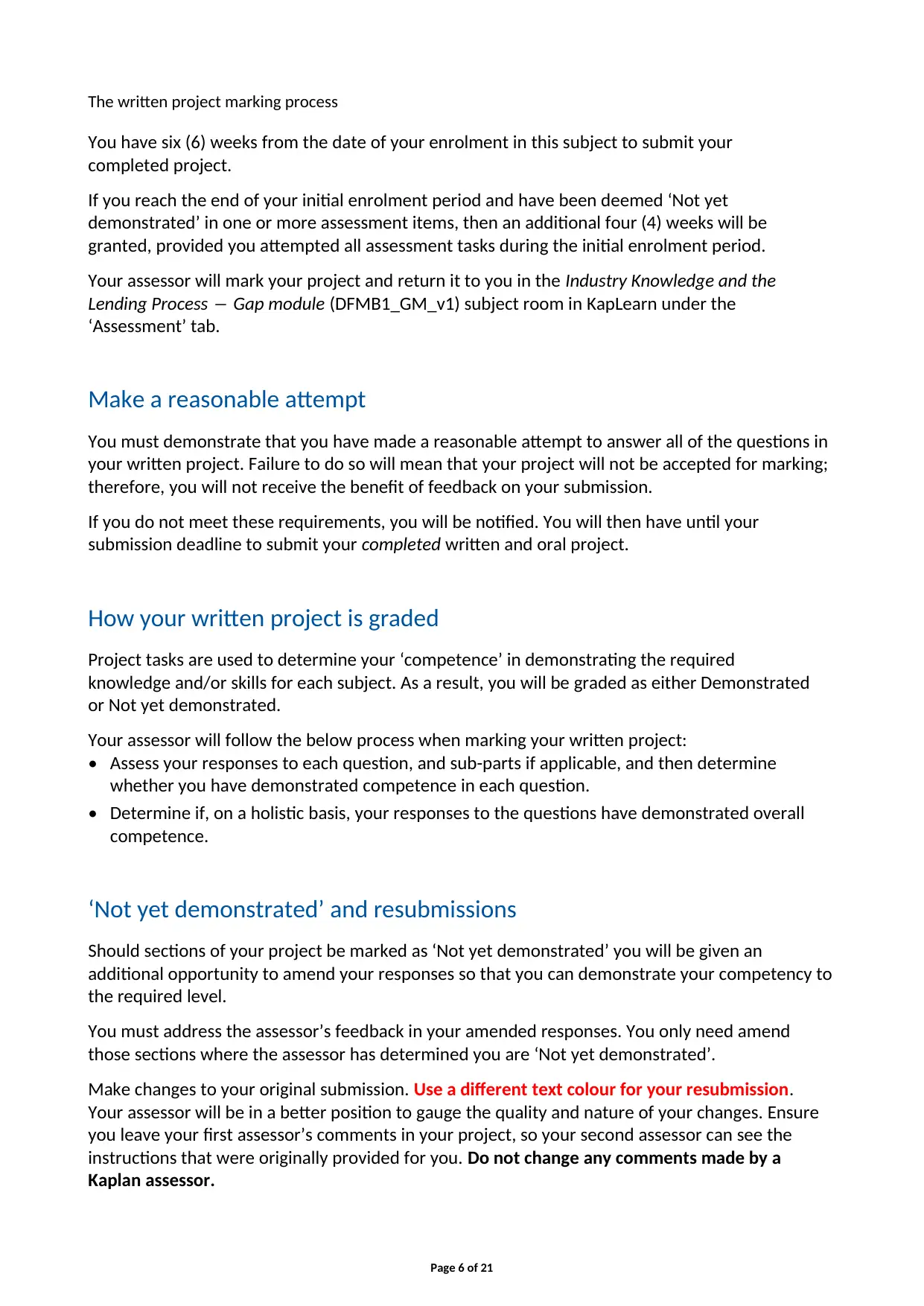
The written project marking process
You have six (6) weeks from the date of your enrolment in this subject to submit your
completed project.
If you reach the end of your initial enrolment period and have been deemed ‘Not yet
demonstrated’ in one or more assessment items, then an additional four (4) weeks will be
granted, provided you attempted all assessment tasks during the initial enrolment period.
Your assessor will mark your project and return it to you in the Industry Knowledge and the
Lending Process ― Gap module (DFMB1_GM_v1) subject room in KapLearn under the
‘Assessment’ tab.
Make a reasonable attempt
You must demonstrate that you have made a reasonable attempt to answer all of the questions in
your written project. Failure to do so will mean that your project will not be accepted for marking;
therefore, you will not receive the benefit of feedback on your submission.
If you do not meet these requirements, you will be notified. You will then have until your
submission deadline to submit your completed written and oral project.
How your written project is graded
Project tasks are used to determine your ‘competence’ in demonstrating the required
knowledge and/or skills for each subject. As a result, you will be graded as either Demonstrated
or Not yet demonstrated.
Your assessor will follow the below process when marking your written project:
• Assess your responses to each question, and sub-parts if applicable, and then determine
whether you have demonstrated competence in each question.
• Determine if, on a holistic basis, your responses to the questions have demonstrated overall
competence.
‘Not yet demonstrated’ and resubmissions
Should sections of your project be marked as ‘Not yet demonstrated’ you will be given an
additional opportunity to amend your responses so that you can demonstrate your competency to
the required level.
You must address the assessor’s feedback in your amended responses. You only need amend
those sections where the assessor has determined you are ‘Not yet demonstrated’.
Make changes to your original submission. Use a different text colour for your resubmission.
Your assessor will be in a better position to gauge the quality and nature of your changes. Ensure
you leave your first assessor’s comments in your project, so your second assessor can see the
instructions that were originally provided for you. Do not change any comments made by a
Kaplan assessor.
Page 6 of 21
You have six (6) weeks from the date of your enrolment in this subject to submit your
completed project.
If you reach the end of your initial enrolment period and have been deemed ‘Not yet
demonstrated’ in one or more assessment items, then an additional four (4) weeks will be
granted, provided you attempted all assessment tasks during the initial enrolment period.
Your assessor will mark your project and return it to you in the Industry Knowledge and the
Lending Process ― Gap module (DFMB1_GM_v1) subject room in KapLearn under the
‘Assessment’ tab.
Make a reasonable attempt
You must demonstrate that you have made a reasonable attempt to answer all of the questions in
your written project. Failure to do so will mean that your project will not be accepted for marking;
therefore, you will not receive the benefit of feedback on your submission.
If you do not meet these requirements, you will be notified. You will then have until your
submission deadline to submit your completed written and oral project.
How your written project is graded
Project tasks are used to determine your ‘competence’ in demonstrating the required
knowledge and/or skills for each subject. As a result, you will be graded as either Demonstrated
or Not yet demonstrated.
Your assessor will follow the below process when marking your written project:
• Assess your responses to each question, and sub-parts if applicable, and then determine
whether you have demonstrated competence in each question.
• Determine if, on a holistic basis, your responses to the questions have demonstrated overall
competence.
‘Not yet demonstrated’ and resubmissions
Should sections of your project be marked as ‘Not yet demonstrated’ you will be given an
additional opportunity to amend your responses so that you can demonstrate your competency to
the required level.
You must address the assessor’s feedback in your amended responses. You only need amend
those sections where the assessor has determined you are ‘Not yet demonstrated’.
Make changes to your original submission. Use a different text colour for your resubmission.
Your assessor will be in a better position to gauge the quality and nature of your changes. Ensure
you leave your first assessor’s comments in your project, so your second assessor can see the
instructions that were originally provided for you. Do not change any comments made by a
Kaplan assessor.
Page 6 of 21
⊘ This is a preview!⊘
Do you want full access?
Subscribe today to unlock all pages.

Trusted by 1+ million students worldwide

We are here to help
If you have any questions about this written project, you can post your query at the ‘Ask your
Tutor’ forum in your subject room. You can expect an answer within 24 hours of your posting from
one of our technical advisers or student support staff.
Page 7 of 21
If you have any questions about this written project, you can post your query at the ‘Ask your
Tutor’ forum in your subject room. You can expect an answer within 24 hours of your posting from
one of our technical advisers or student support staff.
Page 7 of 21
Paraphrase This Document
Need a fresh take? Get an instant paraphrase of this document with our AI Paraphraser
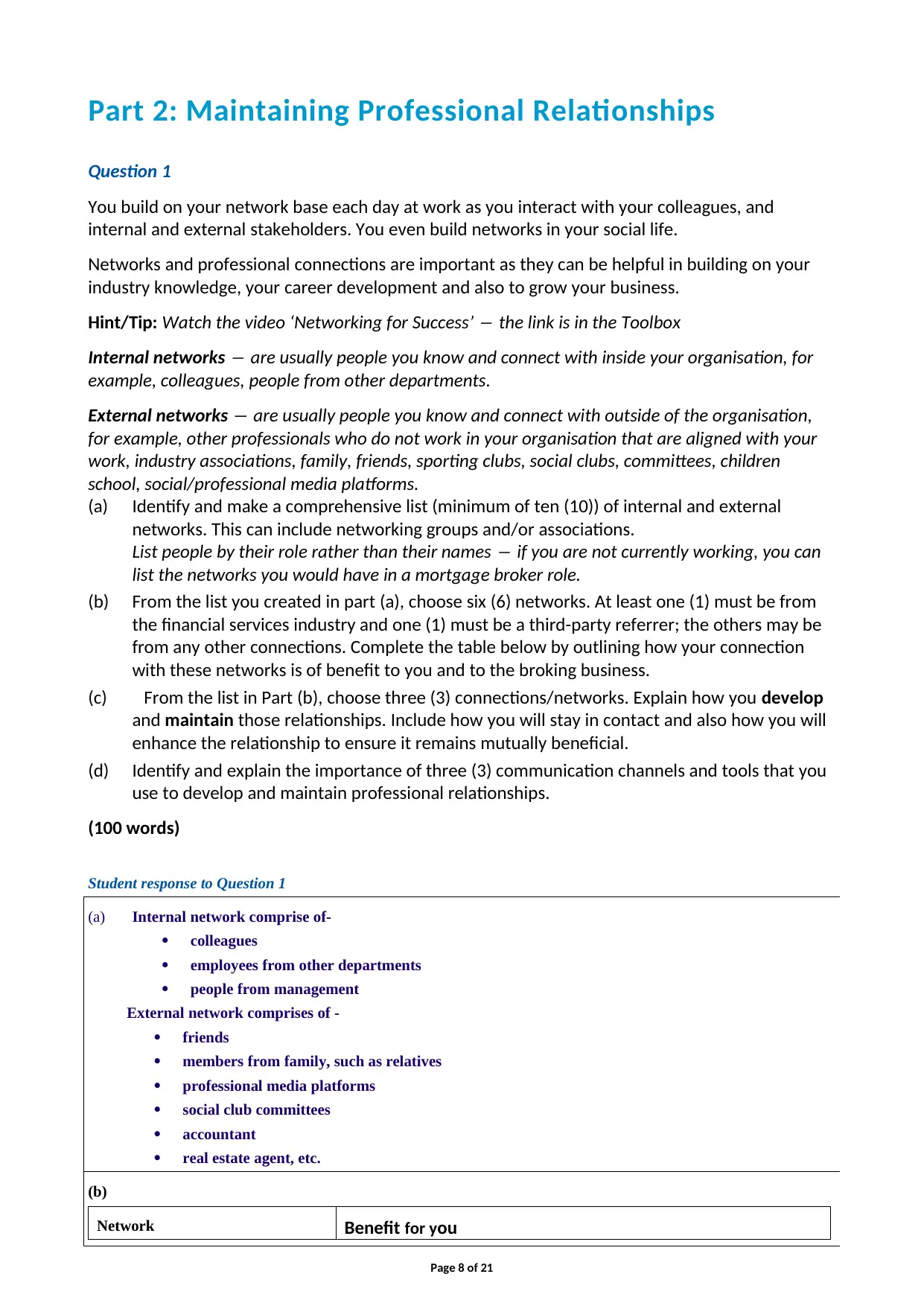
Part 2: Maintaining Professional Relationships
Question 1
You build on your network base each day at work as you interact with your colleagues, and
internal and external stakeholders. You even build networks in your social life.
Networks and professional connections are important as they can be helpful in building on your
industry knowledge, your career development and also to grow your business.
Hint/Tip: Watch the video ‘Networking for Success’ ― the link is in the Toolbox
Internal networks ― are usually people you know and connect with inside your organisation, for
example, colleagues, people from other departments.
External networks ― are usually people you know and connect with outside of the organisation,
for example, other professionals who do not work in your organisation that are aligned with your
work, industry associations, family, friends, sporting clubs, social clubs, committees, children
school, social/professional media platforms.
(a) Identify and make a comprehensive list (minimum of ten (10)) of internal and external
networks. This can include networking groups and/or associations.
List people by their role rather than their names ― if you are not currently working, you can
list the networks you would have in a mortgage broker role.
(b) From the list you created in part (a), choose six (6) networks. At least one (1) must be from
the financial services industry and one (1) must be a third-party referrer; the others may be
from any other connections. Complete the table below by outlining how your connection
with these networks is of benefit to you and to the broking business.
(c) From the list in Part (b), choose three (3) connections/networks. Explain how you develop
and maintain those relationships. Include how you will stay in contact and also how you will
enhance the relationship to ensure it remains mutually beneficial.
(d) Identify and explain the importance of three (3) communication channels and tools that you
use to develop and maintain professional relationships.
(100 words)
Student response to Question 1
(a) Internal network comprise of-
colleagues
employees from other departments
people from management
External network comprises of -
friends
members from family, such as relatives
professional media platforms
social club committees
accountant
real estate agent, etc.
(b)
Network Benefit for you
Page 8 of 21
Question 1
You build on your network base each day at work as you interact with your colleagues, and
internal and external stakeholders. You even build networks in your social life.
Networks and professional connections are important as they can be helpful in building on your
industry knowledge, your career development and also to grow your business.
Hint/Tip: Watch the video ‘Networking for Success’ ― the link is in the Toolbox
Internal networks ― are usually people you know and connect with inside your organisation, for
example, colleagues, people from other departments.
External networks ― are usually people you know and connect with outside of the organisation,
for example, other professionals who do not work in your organisation that are aligned with your
work, industry associations, family, friends, sporting clubs, social clubs, committees, children
school, social/professional media platforms.
(a) Identify and make a comprehensive list (minimum of ten (10)) of internal and external
networks. This can include networking groups and/or associations.
List people by their role rather than their names ― if you are not currently working, you can
list the networks you would have in a mortgage broker role.
(b) From the list you created in part (a), choose six (6) networks. At least one (1) must be from
the financial services industry and one (1) must be a third-party referrer; the others may be
from any other connections. Complete the table below by outlining how your connection
with these networks is of benefit to you and to the broking business.
(c) From the list in Part (b), choose three (3) connections/networks. Explain how you develop
and maintain those relationships. Include how you will stay in contact and also how you will
enhance the relationship to ensure it remains mutually beneficial.
(d) Identify and explain the importance of three (3) communication channels and tools that you
use to develop and maintain professional relationships.
(100 words)
Student response to Question 1
(a) Internal network comprise of-
colleagues
employees from other departments
people from management
External network comprises of -
friends
members from family, such as relatives
professional media platforms
social club committees
accountant
real estate agent, etc.
(b)
Network Benefit for you
Page 8 of 21
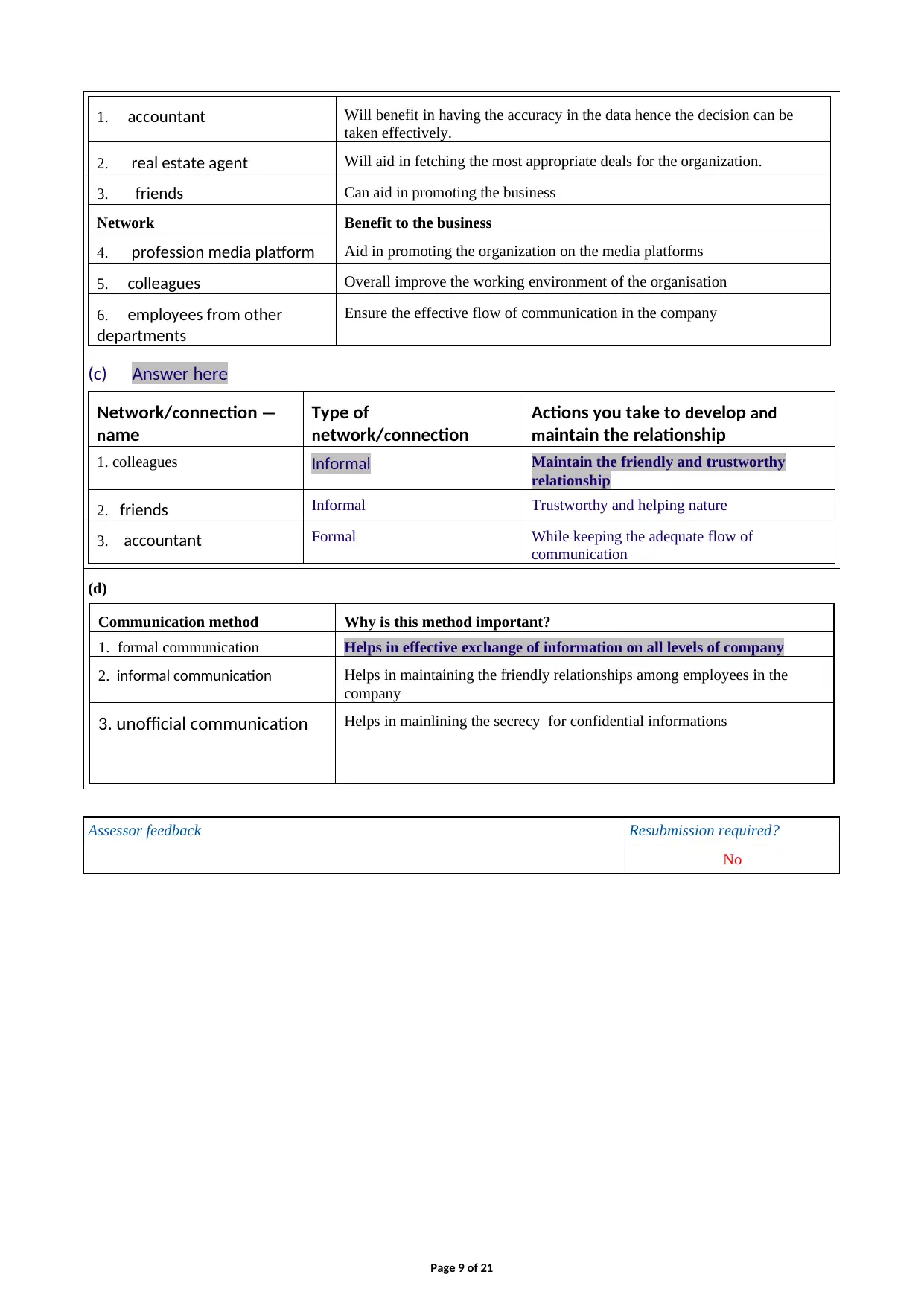
1. accountant Will benefit in having the accuracy in the data hence the decision can be
taken effectively.
2. real estate agent Will aid in fetching the most appropriate deals for the organization.
3. friends Can aid in promoting the business
Network Benefit to the business
4. profession media platform Aid in promoting the organization on the media platforms
5. colleagues Overall improve the working environment of the organisation
6. employees from other
departments
Ensure the effective flow of communication in the company
(c) Answer here
Network/connection —
name
Type of
network/connection
Actions you take to develop and
maintain the relationship
1. colleagues Informal Maintain the friendly and trustworthy
relationship
2. friends Informal Trustworthy and helping nature
3. accountant Formal While keeping the adequate flow of
communication
(d)
Communication method Why is this method important?
1. formal communication Helps in effective exchange of information on all levels of company
2. informal communication Helps in maintaining the friendly relationships among employees in the
company
3. unofficial communication Helps in mainlining the secrecy for confidential informations
Assessor feedback Resubmission required?
No
Page 9 of 21
taken effectively.
2. real estate agent Will aid in fetching the most appropriate deals for the organization.
3. friends Can aid in promoting the business
Network Benefit to the business
4. profession media platform Aid in promoting the organization on the media platforms
5. colleagues Overall improve the working environment of the organisation
6. employees from other
departments
Ensure the effective flow of communication in the company
(c) Answer here
Network/connection —
name
Type of
network/connection
Actions you take to develop and
maintain the relationship
1. colleagues Informal Maintain the friendly and trustworthy
relationship
2. friends Informal Trustworthy and helping nature
3. accountant Formal While keeping the adequate flow of
communication
(d)
Communication method Why is this method important?
1. formal communication Helps in effective exchange of information on all levels of company
2. informal communication Helps in maintaining the friendly relationships among employees in the
company
3. unofficial communication Helps in mainlining the secrecy for confidential informations
Assessor feedback Resubmission required?
No
Page 9 of 21
⊘ This is a preview!⊘
Do you want full access?
Subscribe today to unlock all pages.

Trusted by 1+ million students worldwide
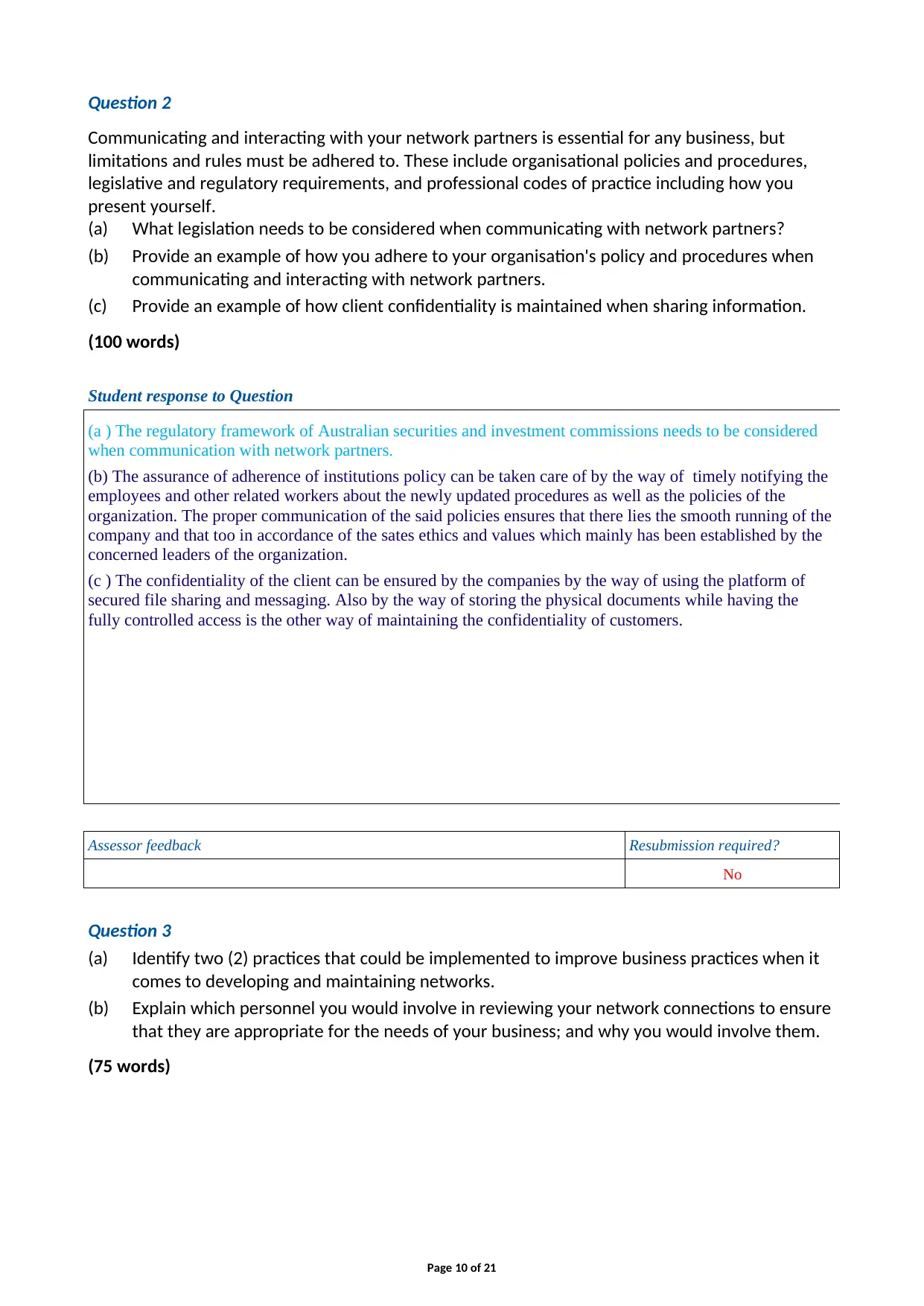
Question 2
Communicating and interacting with your network partners is essential for any business, but
limitations and rules must be adhered to. These include organisational policies and procedures,
legislative and regulatory requirements, and professional codes of practice including how you
present yourself.
(a) What legislation needs to be considered when communicating with network partners?
(b) Provide an example of how you adhere to your organisation's policy and procedures when
communicating and interacting with network partners.
(c) Provide an example of how client confidentiality is maintained when sharing information.
(100 words)
Student response to Question
(a ) The regulatory framework of Australian securities and investment commissions needs to be considered
when communication with network partners.
(b) The assurance of adherence of institutions policy can be taken care of by the way of timely notifying the
employees and other related workers about the newly updated procedures as well as the policies of the
organization. The proper communication of the said policies ensures that there lies the smooth running of the
company and that too in accordance of the sates ethics and values which mainly has been established by the
concerned leaders of the organization.
(c ) The confidentiality of the client can be ensured by the companies by the way of using the platform of
secured file sharing and messaging. Also by the way of storing the physical documents while having the
fully controlled access is the other way of maintaining the confidentiality of customers.
Assessor feedback Resubmission required?
No
Question 3
(a) Identify two (2) practices that could be implemented to improve business practices when it
comes to developing and maintaining networks.
(b) Explain which personnel you would involve in reviewing your network connections to ensure
that they are appropriate for the needs of your business; and why you would involve them.
(75 words)
Page 10 of 21
Communicating and interacting with your network partners is essential for any business, but
limitations and rules must be adhered to. These include organisational policies and procedures,
legislative and regulatory requirements, and professional codes of practice including how you
present yourself.
(a) What legislation needs to be considered when communicating with network partners?
(b) Provide an example of how you adhere to your organisation's policy and procedures when
communicating and interacting with network partners.
(c) Provide an example of how client confidentiality is maintained when sharing information.
(100 words)
Student response to Question
(a ) The regulatory framework of Australian securities and investment commissions needs to be considered
when communication with network partners.
(b) The assurance of adherence of institutions policy can be taken care of by the way of timely notifying the
employees and other related workers about the newly updated procedures as well as the policies of the
organization. The proper communication of the said policies ensures that there lies the smooth running of the
company and that too in accordance of the sates ethics and values which mainly has been established by the
concerned leaders of the organization.
(c ) The confidentiality of the client can be ensured by the companies by the way of using the platform of
secured file sharing and messaging. Also by the way of storing the physical documents while having the
fully controlled access is the other way of maintaining the confidentiality of customers.
Assessor feedback Resubmission required?
No
Question 3
(a) Identify two (2) practices that could be implemented to improve business practices when it
comes to developing and maintaining networks.
(b) Explain which personnel you would involve in reviewing your network connections to ensure
that they are appropriate for the needs of your business; and why you would involve them.
(75 words)
Page 10 of 21
Paraphrase This Document
Need a fresh take? Get an instant paraphrase of this document with our AI Paraphraser

Student response to Question 3
(a) The very first can be the ascertainment of required network. The other can be the usage of good networking
etiquette. One can also start honing for the online options and also can move forward with the idea of joining
groups while targeting the concerned people.
(b) There lies the number of people who can be used for network reviewing, where out of them some are the people
one used to work with such as the past work colleagues. The other can be the friends and employees of the
company.
Assessor feedback Resubmission required?
No
Page 11 of 21
(a) The very first can be the ascertainment of required network. The other can be the usage of good networking
etiquette. One can also start honing for the online options and also can move forward with the idea of joining
groups while targeting the concerned people.
(b) There lies the number of people who can be used for network reviewing, where out of them some are the people
one used to work with such as the past work colleagues. The other can be the friends and employees of the
company.
Assessor feedback Resubmission required?
No
Page 11 of 21
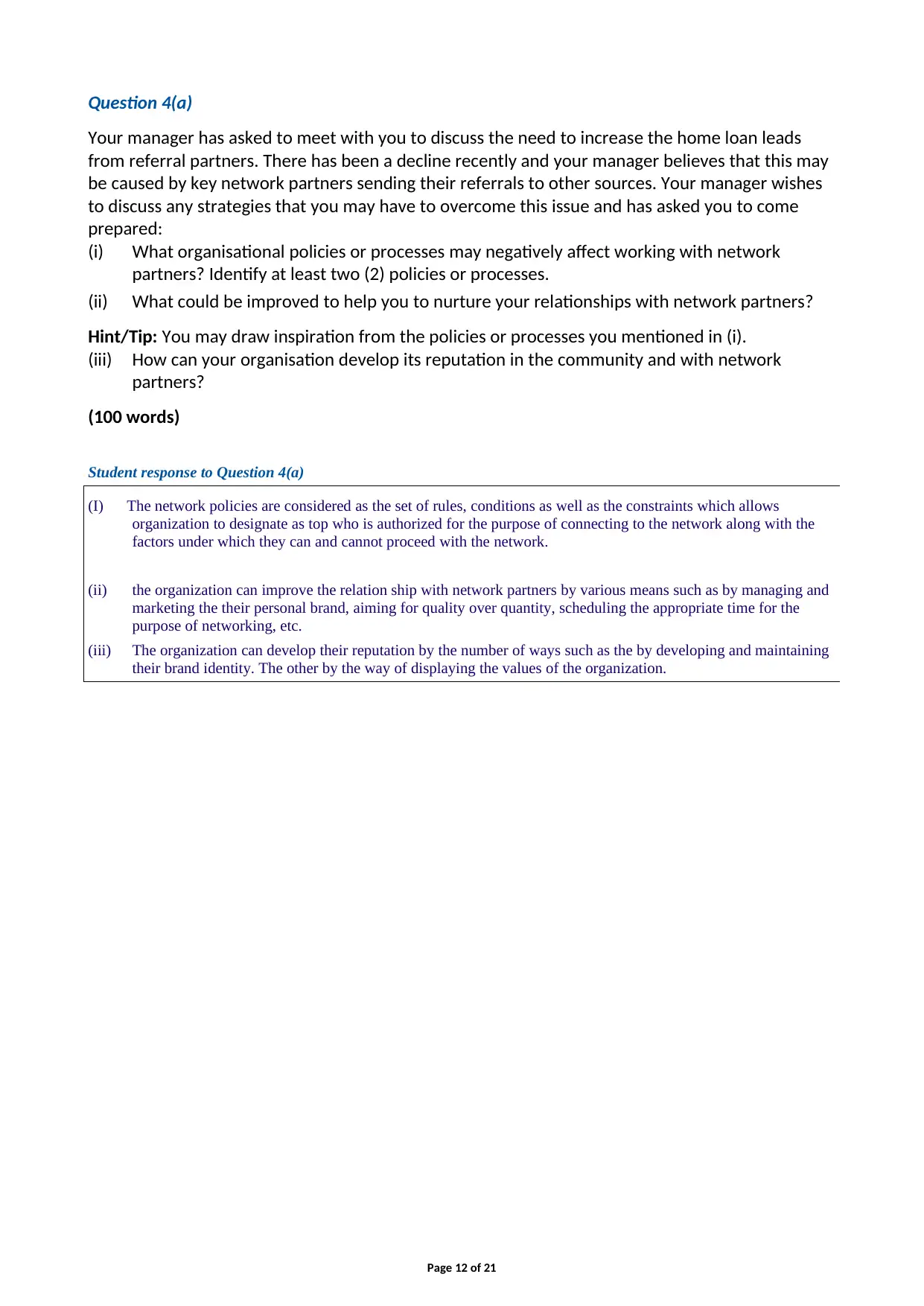
Question 4(a)
Your manager has asked to meet with you to discuss the need to increase the home loan leads
from referral partners. There has been a decline recently and your manager believes that this may
be caused by key network partners sending their referrals to other sources. Your manager wishes
to discuss any strategies that you may have to overcome this issue and has asked you to come
prepared:
(i) What organisational policies or processes may negatively affect working with network
partners? Identify at least two (2) policies or processes.
(ii) What could be improved to help you to nurture your relationships with network partners?
Hint/Tip: You may draw inspiration from the policies or processes you mentioned in (i).
(iii) How can your organisation develop its reputation in the community and with network
partners?
(100 words)
Student response to Question 4(a)
(I) The network policies are considered as the set of rules, conditions as well as the constraints which allows
organization to designate as top who is authorized for the purpose of connecting to the network along with the
factors under which they can and cannot proceed with the network.
(ii) the organization can improve the relation ship with network partners by various means such as by managing and
marketing the their personal brand, aiming for quality over quantity, scheduling the appropriate time for the
purpose of networking, etc.
(iii) The organization can develop their reputation by the number of ways such as the by developing and maintaining
their brand identity. The other by the way of displaying the values of the organization.
Page 12 of 21
Your manager has asked to meet with you to discuss the need to increase the home loan leads
from referral partners. There has been a decline recently and your manager believes that this may
be caused by key network partners sending their referrals to other sources. Your manager wishes
to discuss any strategies that you may have to overcome this issue and has asked you to come
prepared:
(i) What organisational policies or processes may negatively affect working with network
partners? Identify at least two (2) policies or processes.
(ii) What could be improved to help you to nurture your relationships with network partners?
Hint/Tip: You may draw inspiration from the policies or processes you mentioned in (i).
(iii) How can your organisation develop its reputation in the community and with network
partners?
(100 words)
Student response to Question 4(a)
(I) The network policies are considered as the set of rules, conditions as well as the constraints which allows
organization to designate as top who is authorized for the purpose of connecting to the network along with the
factors under which they can and cannot proceed with the network.
(ii) the organization can improve the relation ship with network partners by various means such as by managing and
marketing the their personal brand, aiming for quality over quantity, scheduling the appropriate time for the
purpose of networking, etc.
(iii) The organization can develop their reputation by the number of ways such as the by developing and maintaining
their brand identity. The other by the way of displaying the values of the organization.
Page 12 of 21
⊘ This is a preview!⊘
Do you want full access?
Subscribe today to unlock all pages.

Trusted by 1+ million students worldwide
1 out of 21
Related Documents
Your All-in-One AI-Powered Toolkit for Academic Success.
+13062052269
info@desklib.com
Available 24*7 on WhatsApp / Email
![[object Object]](/_next/static/media/star-bottom.7253800d.svg)
Unlock your academic potential
Copyright © 2020–2025 A2Z Services. All Rights Reserved. Developed and managed by ZUCOL.





